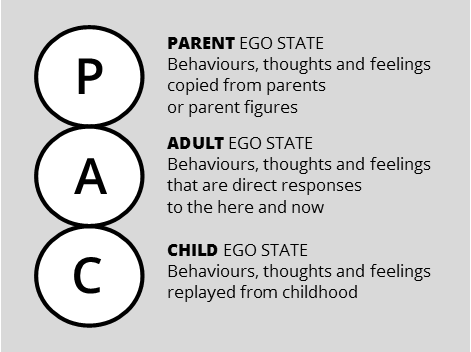
According to the PAC Model, we all have an inner “Parent,” “Adult,” and “Child.” By identifying which one is manifesting itself in any given moment, we can take more control over our thoughts and behaviors.
Transactional Analysis is a therapeutic model that was first developed by Canadian psychiatrist Eric Berne in the late 1950s.
The basic idea behind Transactional Analysis is that we can learn about a person and gain important insights about their personality through analyzing their social interactions. This differed from traditional Freudian psychoanalysis which attempted to gain insights by analyzing the unconscious mind.
One core concept behind Transactional Analysis is that every person has 3 different “ego” states that can manifest themselves in any given social interaction. These 3 ego states include the “Parent,” “Adult,” and “Child” – also known as the PAC Model.
While this is just one framework for viewing our behaviors, it does touch on the fundamental insight that we often have “multiple selves” – different aspects of our personality that come out depending on the situation and context.
This is a helpful fact to understand about yourself because it teaches that you have a choice which aspects of yourself to feed into.
Once you understand the PAC model, you can more easily identify when your inner “Parent,” “Child” or “Adult” are speaking. Let’s learn more about this model and how we can use it to improve ourselves.
The PAC Model: Parent, Adult, and Child
Each “ego state” in the PAC Model represents a different type of information we learned throughout life.
Here’s a simple illustration of the PAC model:

The Parent is a recording of external thoughts and feelings observed by your parents, parental guardian, or other strong authority figures like teachers, doctors, or priests. It’s often driven by the desire to judge (“right” or “wrong”), including the desire to reward or punish certain behaviors. Many family patterns that you’ve picked up represent information stored in the Parent.
Common language of the Parent: “Should/Shouldn’t,” “Do/Do Not,” “Right/Wrong,” “Yes/No,” “Because I said so,” “It is what it is,” “Never tell a lie,” “Pay your bills,” “Those are the rules.”
The Child is a recording of internal thoughts and feelings replayed from your childhood. It’s often driven by the desire to be accepted, be loved, and be paid attention to. If a person lacks positive childhood experiences early on in life, their Child will often develop “games” or unhealthy habits later in life to feel accepted, loved, or paid attention to.
Common language of the Child: “It’s my fault,” “I’m not OK,” “I’m not good enough,” I’m stupid,” “I’m not strong enough,” “Help me,” “Give me,” “Protect me,” “Poor me,” “Please don’t kick me,” “I want.”
The Adult is your rational analysis of your thoughts, feelings, and observations in the moment (taking in information from your surroundings), but also recognizing how your “Child” or “Parent” may be influencing your responses too. The Adult has the ability to step back, reflect on all the information they have, and make the best decision available to them.
Common language of the Adult: “I have a choice,” “Let’s learn more first,” “I’ll wait/be patient,” “Why is that?” “Let’s test that,” “There are many possibilities,” “Let me think about it.”
The Adult is often referred to as the “computer” in the PAC Model – it does all of the conscious thinking and information processing.
If we were to use more modern psychology terms, we would call the “Adult” our System 2 (“slow, rational, effortful” thinking) and our “Parent” and “Child” would be considered a part of our System 1 (“fast, automatic, impulsive” responses). Check out Daniel Kahneman’s Thinking, Fast and Slow for more on this.
The good news is that our System 1 (“automatic responses”) can be changed or altered through interventions by our System 2 (“effortful thinking”).
The “Adult” can always step in and silence (or ignore) the advice of the “Parent” or “Child” in any given moment, but it requires constant awareness and vigilance.
Building a healthy Adult takes effort and constant development.
According to the classic book I’m OK–You’re OK by Thomas Harris, much of the information that represents the “Child” and “Parent” is formulated by the time we reach 4-5 years old. He incorrectly states this information is perfectly recorded in the brain (a theory that has now been debunked), but the basic principle still applies: the earliest stages in life often have the biggest imprint on us.
The “Adult” however continues to evolve and to learn so long as we are alive and can think, assuming we are connecting with it.
The moment you ask yourself, “Which ego state is speaking right now?” you are tapping into your Adult. The Adult analyzes the information coming from the Child and the Parent, but it can also question that information and disregard it.
A child who grew up with parents who hold some type of negative or prejudiced belief may end up adopting that belief in themselves. For example, “Those types of people are bad” or “Life sucks and then you die” are often beliefs driven by the Parent (judgment).
It’s only after the Adult questions that information and learns new information that the belief can be changed, altered, or integrated into a new worldview that is healthier and more mature.
Please note: The Adult can also judge “right” or “wrong,” but it’s a judgment based on information, and evidence, rather than blind allegiance to something they learned from their Parent.
Of course, not everything coming from the “Child” or “Parent” is faulty or unhealthy information, there can be a lot of good information there too.
The Adult often discovers that what their Parent taught them was useful and correct (“It IS a good idea to eat my vegetables and do my homework on time!”), while other times the Adult finds out that the Parent was misguided or incorrect (“Those people aren’t actually such bad people after all!”).
The Child too can carry a lot of positive information, such as the spirit of play, exploration, curiosity, and joyful moments like the first time eating ice cream, playing with a puppy, or discovering something new. When one talks about unleashing their “Inner Child” in a positive way, they are usually referring to this playful and creative attitude.
The inner Parent and Child aren’t necessarily good or bad, but they need to be integrated into a mature Adult.
A Framework for Analyzing Yourself and Others
The PAC Model is very simple to understand, but it also has a wide-range of applications.
First and foremost, it’s a good framework for analyzing yourself and your own responses to other people. Reflect back on a past moment when you embarrassed yourself or acted in an unhealthy way, what was the thought process? Did your inner Parent or Child take over?
If you can begin to identify what types of people and situations trigger your inner Parent or Child, you can start finding ways to bring in your Adult and let it take more control over your responses.
The PAC Model is also very useful for analyzing other people and their responses to you. Instead of taking things personally, you can begin to recognize when someones Child or Parent takes over – an important reminder when dealing with difficult people.
The more you can recognize the Parent, Adult, and Child in everyone (including yourself), the more power and control you’ll have over your thoughts, behaviors, and relationships with others.
Enter your email to stay updated on new articles in self improvement:
